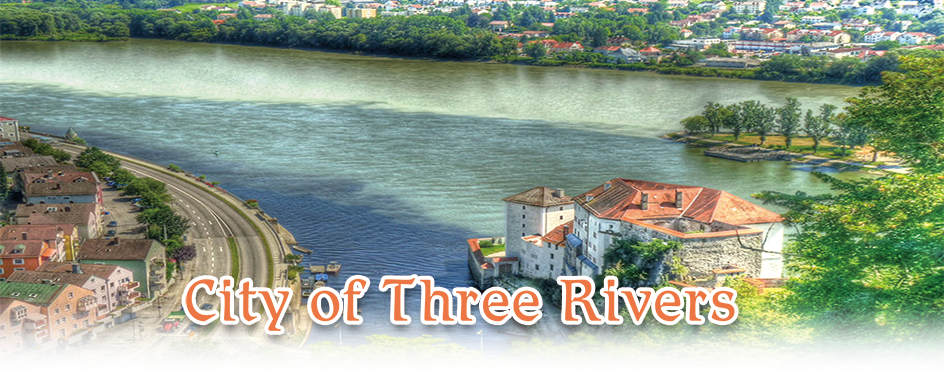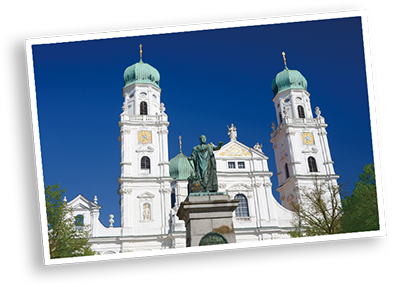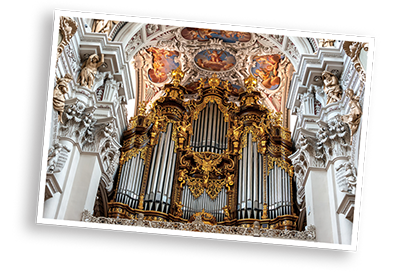

Sitting on the border near Austria, Passau is a university town tucked into the southeast corner of Bavaria, Germany. With a long history dating back over 2,000 years, Passau rose to prominence as a trading centre during the Middle Ages, but now seems to have faded into irrelevance. Its obscurity is best illustrated in travel books on Germany: while Munich, the state capital of Bavaria, is typically discussed over a full chapter, Passau can count itself lucky if it gets even a short paragraph.
The extensive coverage of tourist spots in large cities conveys a subtle message about travelling: if you want to see something great, just go somewhere big. If size is an indicator of a place’s glamour, there should be little to admire about Passau, which is less than one quarter of the size of Munich. Yet Passau possesses its own forms of greatness, both fathomable and unfathomable.
Back in the days of the Holy Roman Empire, Passau was the capital of the Empire’s largest diocese, which covered present-day Austria and Hungary. Today, Passau is still home to many churches and abbeys, including St Stephen’s Cathedral. With a white façade and green onion domes, the cathedral may not be eye-catching at first sight. Yet behind its modest appearance is an ornate interior embellished with beautiful frescos, stucco, and, most notably, Europe’s largest organ.
 At one time the largest of its kind in the world, the organ at St Stephen’s Cathedral is in fact an ensemble of five individual organs. With a total of 17,974 pipes producing a wide range of pitches and tones, the organ possesses great flexibility and is perfect for hymns and symphonic music alike. The cathedral still holds organ recitals every day from May to September, showcasing the sonorous timbre of the instrument. When the organ is played, the cathedral is filled with an air of solemnity in an instant that gives everyone—including an actor-turned-politician who goes by the name of Arnold Schwarzenegger—a profound sense of humility.
At one time the largest of its kind in the world, the organ at St Stephen’s Cathedral is in fact an ensemble of five individual organs. With a total of 17,974 pipes producing a wide range of pitches and tones, the organ possesses great flexibility and is perfect for hymns and symphonic music alike. The cathedral still holds organ recitals every day from May to September, showcasing the sonorous timbre of the instrument. When the organ is played, the cathedral is filled with an air of solemnity in an instant that gives everyone—including an actor-turned-politician who goes by the name of Arnold Schwarzenegger—a profound sense of humility.
One of Arnold Schwarzenegger’s childhood dreams was to listen to organ music at St Stephen’s Cathedral. When he finally fulfilled his wish at the age of 70 and set foot in the cathedral in 2017, the Hollywood star and former Governor of California, with all his fame and status, was just another curious visitor attending an organ recital open to the public. He squeezed into a narrow pew, took numerous photos of the organ in awe, and marvelled at the acoustics. In the face of something mighty, we may feel humbled, but not in a negative way.
 In Passau there is more than one way to find pleasure in feeling dwarfed. Known as the “City of Three Rivers”, Passau is where the Danube is joined by two tributaries, the Inn and the Ilz. Walk for a few minutes after leaving St Stephen’s Cathedral and you can enjoy the sight of the rivers. Gurgling and flowing endlessly, rivers may be a symbol of banal monotony, reminiscent of a dull stretch of motorway. But not in Passau. When the rivers converge here, they do not mix with each other. Viewed from a vantage point, the three bodies of water are of distinct colours, varying in shape and length, as if they were brushstrokes delicately added to an oil painting. The Ilz, the shortest and narrowest of the three, is a swirling thin black line, in stark contrast to the blue-brown Danube and the green whitish Inn, which resemble two thick layers of impasto paint running parallel across a square of canvas and extending all their way into infinity. The picturesque landscape has given Passau its enduring nickname: “Venice of Bavaria”.
In Passau there is more than one way to find pleasure in feeling dwarfed. Known as the “City of Three Rivers”, Passau is where the Danube is joined by two tributaries, the Inn and the Ilz. Walk for a few minutes after leaving St Stephen’s Cathedral and you can enjoy the sight of the rivers. Gurgling and flowing endlessly, rivers may be a symbol of banal monotony, reminiscent of a dull stretch of motorway. But not in Passau. When the rivers converge here, they do not mix with each other. Viewed from a vantage point, the three bodies of water are of distinct colours, varying in shape and length, as if they were brushstrokes delicately added to an oil painting. The Ilz, the shortest and narrowest of the three, is a swirling thin black line, in stark contrast to the blue-brown Danube and the green whitish Inn, which resemble two thick layers of impasto paint running parallel across a square of canvas and extending all their way into infinity. The picturesque landscape has given Passau its enduring nickname: “Venice of Bavaria”.
While such majestic natural scenery may be interpreted as divine intervention, there is of course a scientific explanation for this phenomenon. Every river has its own composites and sediments. Their amounts and types, along with the flow velocity and volume of the waters, help shape the appearance of a river. The Ilz, for example, picks up humic substances from the bog as it flows through the swampy countryside of the Black Forest before joining the Danube, thereby becoming black and earning itself the nickname the “Black Pearl”. Meanwhile, the Inn collects water from both the thawing glaciers of the Alps and minerals from rocks, hence its lighter colour. Knowing such facts may take away the romantic notion of the rivers, but they give us a consoling lesson in life: it is the tiniest particles that create the greatest landscape.
Is it worth going to Passau just for the church organ and a view of the rivers? After all, there are bigger organs elsewhere in the world now. Rivers, as one may say, are just fish roads. Passau, almost as small as Hong Kong Island, is no more than a dot on the world map. But isn’t the world map made up of a multitude of dots?













